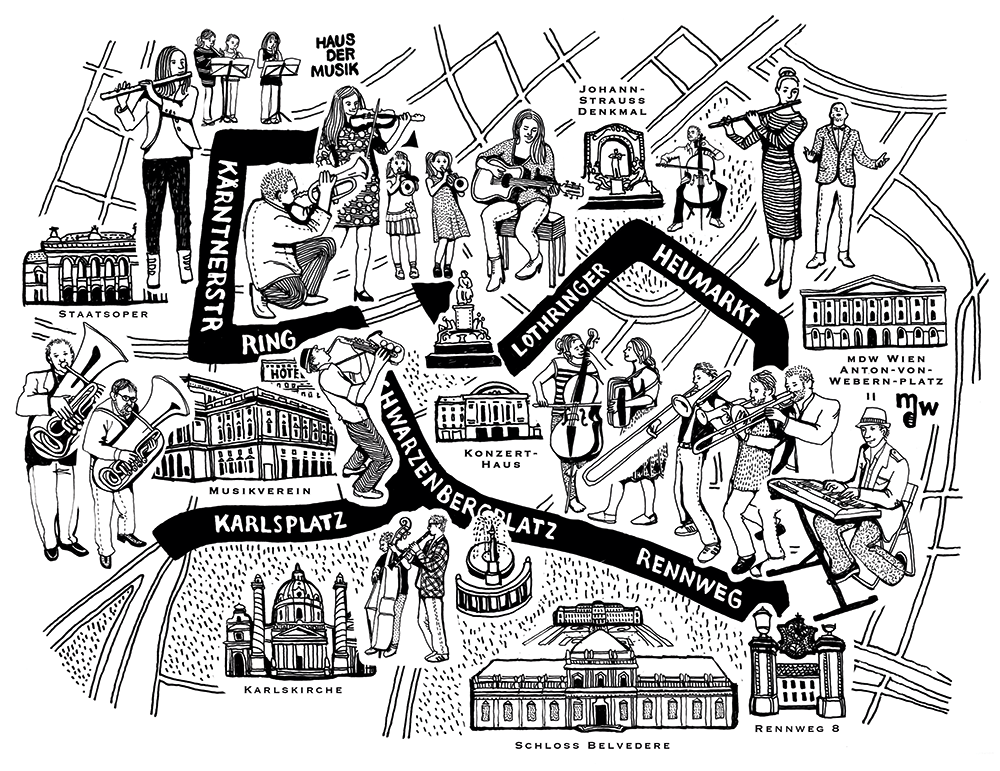„Das Jubiläum der mdw bietet einen hervorragenden Anlass, etwas Großes auf die Beine zu stellen!“ Anlässlich von 200 Jahren mdw, soll das oft verborgene, aktuelle und historische Zusammenwirken aller Bildungsebenen, Institutionen und beteiligten Personen, ohne das es keine lebendige Kunst und Kultur gäbe, erkenn- und erlebbar werden. Ausgehend davon initiierten Wolfgang Aichinger, Institutsleiter des Josef Hellmesberger Instituts für Streichinstrumente, Gitarre und Harfe, und Dietmar Flosdorf, Lehrender für Musikvermittlung am selbigen Institut, gemeinsam mit ihrem Team das Projekt Klangketten.

Klanginseln – Hotspots verteilt in der Wiener Innenstadt, die von den Instituten der mdw sowie weiteren eingeladenen Institutionen und Personen aus dem schulischen und kulturellen Bereich, bespielt werden. Die Ideen zur Gestaltung der Klanginseln sind höchst unterschiedlich: vom öffentlichen Proben einer Cello-Klasse, bei der PassantInnen eingeladen sind, das Gehörte zu kommentieren, über angebotenes Sprechtraining durch Studierende des Max Reinhardt Seminars für zufällig Vorbeikommende oder eine Walzer-Kapelle vor dem Johann-Strauss-Denkmal im Stadtpark bis hin zum Ausprobieren von unterschiedlichen Musikinstrumenten. „Die Begrenzung kann nur jene der Fantasie sein“, hebt Wolfgang Aichinger hervor. Die Bedeutung des Vermittelns und Rezipierens von Kunst steht im Zentrum. Die klassische, sich gegenüberstehende Konstellation der Vorführenden und des Publikums wird aufgelöst. Auch auf den üblichen örtlichen Rahmen eines Konzert- oder Theatersaales, in dem die BesucherInnen die Vortragenden aus dem Zuschauerbereich wahrnehmen und beobachten, wird verzichtet. Vielmehr geht es darum, zu vermitteln, was an der mdw täglich gelehrt und geübt wird, und das in der spontanen Gegebenheit des öffentlichen Raums, mit Menschen, die zum Teil zufällig am Geschehen teilnehmen. Dadurch ergibt sich auch die Möglichkeit, jene zu erreichen, die üblicherweise nicht ins Theater, in die Oper oder in ein Konzert gehen. Die Rollen der VermittlerInnen und der RezipientInnen werden aufgebrochen, da niemand auf nur eine Rolle festgelegt ist: Indem die PassantInnen selbst am öffentlichen Unterricht teilnehmen oder das Gehörte kommentieren, werden sie selbst zu VermittlerInnen und die VermittlerInnen zu ZuhörerInnen.
Da Musikvermittlungsinitiativen heute eine wachsende Aufmerksamkeit erfahren, könnte das Projekt als rein pädagogische Initiative missverstanden werden, da es den Auftrag durch die Kunst die Gesellschaft zu erreichen in den Mittelpunkt stellt. Aber das ist nicht alleinige Aufgabe der PädagogInnen, sondern vielmehr allgemein die der MusikerInnen und darstellenden KünstlerInnen. Das Projekt Klangketten möchte auch deutlich machen, wie sich Vermittlung und Rezeption von Kunst in ihrer gegenseitigen Abhängigkeit auf Augenhöhe begegnen können, betonen die Projektinitiatoren.
Der besondere Reiz ist auch das Hinaustreten in den öffentlichen Raum. Die Darbietung an ungewöhnlichen Orten hilft, von der Frage „Wer spielt besser?“ wegzukommen. Stattdessen sollten Studierende die Frage „Wie kann ich Menschen begegnen und ihnen meine Kunst vermitteln und für sie begeistern?“ in den Mittelpunkt stellen, ist Wolfgang Aichinger überzeugt. In ähnlichen Projekten haben er und Dietmar Flosdorf die Erfahrung gemacht, dass das Zusammenbringen mit Menschen, die oft nicht die Möglichkeit zur kulturellen Teilhabe haben oder sich dieser nicht bewusst sind, bei den Studierenden besonders bleibende Eindrücke hinterlässt und die Wertigkeit des Vermittelns und das Bewusstsein für ihre Rolle als KünstlerInnen in der Gesellschaft stärkt.
Das Zugehen auf das Publikum und die Einladung zur aktiven Teilnahme schwächt die Fokussierung auf das Elitäre, wobei die Exzellenz nicht in Abrede gestellt werden soll. Die PassantInnen und TeilnehmerInnen können sich am Erlebten bereichern und begreifen, was Exzellenz bedeutet. „Im Spitzensport ist jedem klar, dass die Jagd nach Hundertstelsekunden Exzellenz ist, aber was es heißt, in ein Orchester wie die Wiener Philharmoniker aufgenommen zu werden, ist wenigen bewusst“, sagt Dietmar Flosdorf. Dieses Bewusstsein zu stärken ist eines der Anliegen des Projektes. Die Klangketten richten sich aber auch an die mdw und ihre Angehörigen. Studierende, Lehrende, AbsolventInnen und MitarbeiterInnen verschiedener Institute sollen sich „verketten“, damit ein Gedankenaustausch oder eine Zusammenarbeit angeregt wird, die vorher vielleicht noch nicht bestand.
Der Höhepunkt des Projektes am Veranstaltungstag ist die Verbindung der einzelnen Klanginseln zur Klangkette – hör- und sichtbar gemacht, indem ein Lied oder ein Klang durch die Kette, die aus den einzelnen TeilnehmerInnen der Klanginseln und der PassantInnen besteht, weitergegeben wird. Klang als verbindenes Element wird somit veranschaulicht und hörbar.
Das Projekt Klangketten ist eine Einladung und ein Geschenk an die mdw zu ihrem Jubiläum, wobei der verbindende Charakter auch nachhaltig weiter wirken soll. Was wünschen Wolfgang Aichinger und Dietmar Flosdorf der mdw zum Jubiläum? „Die Aufbruchstimmung und die intensivierte Zusammenarbeit an der mdw sollen anhalten“, meint Wolfgang Aichinger. „Wenn die Menschen in 200 Jahren auf die mdw zurücksehen, sollen sie dies in ebensolcher Bewunderung tun, wie wir heute auf den visionären Beginn blicken, der den Weg zur institutionalsierten Musikausbildung für jeden und auf allen Bildungsebenen bereitet hat“, fügt Dietmar Flosdorf hinzu.
Die Klangketten verbinden somit die Geschichte mit der Gegenwart und Zukunft und bilden eine Brücke aus dem Inneren der mdw mit ihren Studierenden, Lehrenden und MitarbeiterInnen nach außen zu den PassantInnen und TeilnehmerInnen der Klanginseln.
- Finden Sie alle Informationen zum Projekt und wie Sie selbst mitmachen können unter www.mdw200.at/klangketten

